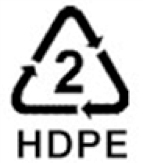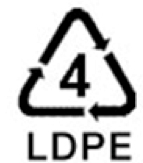Polymer Division
WHY RECYCLING ?
Can you imagine a world without plastic ?
Plastic is one of the greatest and evolutionary discoveries of mankind. The first plastic was developed in 1855 to replace ivory. A man by the name of Alexander Parkes came up with the idea of a material- Something that can be can be easily molded and shaped. It takes about 450 years just for one plastic bottle to break down in the ground!! certainly the most shocking is that nearly every piece of plastic EVER made still exists today.
Slim down your Bin and Save Earth!
Follow the 3 R’s
- Reduce the waste that you create.
- Reuse the possible items.
- and rest is our part, we do Recycling.
WHAT IS RECYCLING ?
It’s the process of recovering waste plastic and reprocess them into useful products. Typically a plastic is not recycled into the same type of plastic, and products made from recycled plastics are often not recyclable. Due to the high molecular weight of their large polymer chains, It requires more processing compared to other materials like, glass and metal. Heating alone is not enough to dissolve such a large molecule, so plastics must often be of nearly identical composition to mix efficiently.
CHALLENGES IN RECYCLING..
When different types of plastics are melted together, they tend to phase-separate, like oil and water, and set in these layers. The phase boundaries cause structural weakness in the resulting material, meaning that polymer blends are useful in only limited applications. Another barrier to recycling is the widespread use of dyes, fillers, and other additives in plastics. The polymer is generally too viscous to economically remove fillers, and would be damaged by many of the processes that could cheaply remove the added dyes. Additives are less widely used in beverage containers and plastic bags, allowing them to be recycled more often. Yet another barrier to removing large quantities of plastic from the waste stream and landfills is the fact that many common but small plastic items lack the universal triangle recycling symbol and accompanying number.
What Plastics can be Recycled ?
Plastic items are labeled on their base with a stamp that shows a triangle made of an arrow, with a number in the middle. But what do these numbers mean? Let’s explore.

#1: PETE or PET Most often called PET, #1 bottles are made of
polyethylene terephthalate. This plastic is most commonly used for water and soda bottles, peanut butter and other food jars, and such. Only about 20% of these containers are recycled; they can be made into polar fleece, carpet, new containers and more. These are the plastics most commonly picked up by curbside recycling programs.

#2: High Density Polyethylene (HDPE) HDPE is a very
versatile plastic that is used in a variety of products. HDPE is used for thin products such as milk jugs and juice bottles, butter and yogurt tubs, cereal box bags, sandwich bags, shopping bags and garbage bags, among other things. #2 plastics are commonly picked up with curbside recycling and can be recycled into new bottles, floor tile, drainage pipe, lumber, fencing and more.

#3: Vinyl or PVCThese bottles are most often used for storing
cleaners and detergents, as well as plumbing pipes, but can also be found in some medical products, siding, building windows and more. #3 plastic is rarely recycled, but some facilities will take it to be recycled into siding or lumber products. Heating PVC releases many toxins, thus they cannot be burned and melting must be highly controlled.

#4: Low Density Polyethylene (LDPE)These plastics are
usually thin and pliable, and are used for shopping bags, squeezable bottles, frozen food containers, clothing, furniture and more. These plastics are rarely recycled, though more facilities are starting to accept them.

#5: Polypropylene (PP)) Most commonly found in some
condiment bottles, as well medicine bottles and straws, PP plastics can be recycled into brushes, battery cables, and a huge variety of materials. However, they have rarely been accepted by most recycling facilities. Recently, though, more curbside recyclers have started to accept them.

#6: Polystyrene (PS)) Most commonly used in foam cups,
plates, egg cartons and carry-out containers, PS plastics can be recycled into insulation, among other things, but rarely are. Recent research has suggested that this plastic can leach toxins into food when heated, so some companies are moving away from this product for food containers.

#7: (Miscellaneous ) This category basically refers to a variety
of plastics (from sunglasses to water bottles) that do not fit into other categories. These are very rarely recycled.
How Can Recycling be More Efficient :
Recycling is a challenging business which requires an expenditure of energy and the use of water. Everyone can make recycling more efficient by helping minimize the required steps to recycling. This includes putting only recyclable material into the recycle bins (checking the number of the item against the allowable recyclables by the company), and removing caps which are made of lesser plastic that can rarely be recycled. While many curbside pick-up companies do not require customers to remove labels or clean the recyclables, doing so does make the job of recycling easier and less expensive, allowing the recycling company to recycle more material and thus be more efficient.
HOW RECYCLING HAPPENS ?
- SORTING
- CRUSHING/ SHREDDING
- EXTRUDING
- QC
The first step is to sort out the different types of recyclable products at a recycling facility. We follow single stream recycling, in which all items are collected at once, so first it's necessary to separate out basic categories. Next, the plastic needs to be sorted for recycling. Plastic is sorted by types.
After sorting, the plastic is ground into chips or flakes. The shredding stage is when the waste plastic is taken and loaded on to conveyor belts or directly in to huge hoppers that funnel the clean scrap towards rotating metal teeth that rip the plastic in to small pellets which are bagged up afterwards ready for testing.
This is the final stage in recycling plastic, this involves melting the clean shredded plastic and extruding in to the form of pellets which then go on to manufacture the next lot of plastic products.
We have a well-equipped and professional QC department, to ensure that our products are in line with the standards.
Copyright © 2020 All rights reserved

